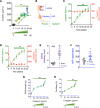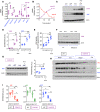Vasopressin mediates fructose-induced metabolic syndrome by activating the V1b receptor
- PMID: 33320834
- PMCID: PMC7821599
- DOI: 10.1172/jci.insight.140848
Vasopressin mediates fructose-induced metabolic syndrome by activating the V1b receptor
Abstract
Subjects with obesity frequently have elevated serum vasopressin levels, noted by measuring the stable analog, copeptin. Vasopressin acts primarily to reabsorb water via urinary concentration. However, fat is also a source of metabolic water, raising the possibility that vasopressin might have a role in fat accumulation. Fructose has also been reported to stimulate vasopressin. Here, we tested the hypothesis that fructose-induced metabolic syndrome is mediated by vasopressin. Orally administered fructose, glucose, or high-fructose corn syrup increased vasopressin (copeptin) concentrations and was mediated by fructokinase, an enzyme specific for fructose metabolism. Suppressing vasopressin with hydration both prevented and ameliorated fructose-induced metabolic syndrome. The vasopressin effects were mediated by the vasopressin 1b receptor (V1bR), as V1bR-KO mice were completely protected, whereas V1a-KO mice paradoxically showed worse metabolic syndrome. The mechanism is likely mediated in part by de novo expression of V1bR in the liver that amplifies fructokinase expression in response to fructose. Thus, our studies document a role for vasopressin in water conservation via the accumulation of fat as a source of metabolic water. Clinically, they also suggest that increased water intake may be a beneficial way to both prevent or treat metabolic syndrome.
Keywords: Carbohydrate metabolism; Endocrinology; Metabolism; Obesity.
Conflict of interest statement
Figures







Similar articles
-
Role of fructose and fructokinase in acute dehydration-induced vasopressin gene expression and secretion in mice.J Neurophysiol. 2017 Feb 1;117(2):646-654. doi: 10.1152/jn.00781.2016. Epub 2016 Nov 16. J Neurophysiol. 2017. PMID: 27852737 Free PMC article.
-
Opposing effects of fructokinase C and A isoforms on fructose-induced metabolic syndrome in mice.Proc Natl Acad Sci U S A. 2012 Mar 13;109(11):4320-5. doi: 10.1073/pnas.1119908109. Epub 2012 Feb 27. Proc Natl Acad Sci U S A. 2012. PMID: 22371574 Free PMC article.
-
Deletion of Fructokinase in the Liver or in the Intestine Reveals Differential Effects on Sugar-Induced Metabolic Dysfunction.Cell Metab. 2020 Jul 7;32(1):117-127.e3. doi: 10.1016/j.cmet.2020.05.012. Epub 2020 Jun 4. Cell Metab. 2020. PMID: 32502381 Free PMC article.
-
Vasopressin V1a and V1b receptors: from molecules to physiological systems.Physiol Rev. 2012 Oct;92(4):1813-64. doi: 10.1152/physrev.00035.2011. Physiol Rev. 2012. PMID: 23073632 Review.
-
[Vasopressin receptor knockout mice as an animal model of psychiatric disorders].Nihon Shinkei Seishin Yakurigaku Zasshi. 2006 Apr;26(2):101-5. Nihon Shinkei Seishin Yakurigaku Zasshi. 2006. PMID: 16722468 Review. Japanese.
Cited by
-
Metabolic effects of vasopressin in pathophysiology of diabetic kidney disease.Front Endocrinol (Lausanne). 2023 Sep 18;14:1176199. doi: 10.3389/fendo.2023.1176199. eCollection 2023. Front Endocrinol (Lausanne). 2023. PMID: 37790608 Free PMC article. Review.
-
The Speed of Ingestion of a Sugary Beverage Has an Effect on the Acute Metabolic Response to Fructose.Nutrients. 2021 Jun 2;13(6):1916. doi: 10.3390/nu13061916. Nutrients. 2021. PMID: 34199607 Free PMC article.
-
The role of ChREBP in carbohydrate sensing and NAFLD development.Nat Rev Endocrinol. 2023 Jun;19(6):336-349. doi: 10.1038/s41574-023-00809-4. Epub 2023 Apr 13. Nat Rev Endocrinol. 2023. PMID: 37055547 Review.
-
Fructose Induces Pulmonary Fibrotic Phenotype Through Promoting Epithelial-Mesenchymal Transition Mediated by ROS-Activated Latent TGF-β1.Front Nutr. 2022 May 27;9:850689. doi: 10.3389/fnut.2022.850689. eCollection 2022. Front Nutr. 2022. PMID: 35711535 Free PMC article.
-
The damaging duo: Obesity and excess dietary salt contribute to hypertension and cardiovascular disease.Obes Rev. 2023 Aug;24(8):e13589. doi: 10.1111/obr.13589. Epub 2023 Jun 19. Obes Rev. 2023. PMID: 37336641 Free PMC article. Review.
References
-
- Narain A, et al. Soft drink intake and the risk of metabolic syndrome: A systematic review and meta-analysis. Int J Clin Pract. 2017;71(2) - PubMed
Publication types
MeSH terms
Substances
Grants and funding
LinkOut - more resources
Full Text Sources
Other Literature Sources
Medical
Molecular Biology Databases
Research Materials

